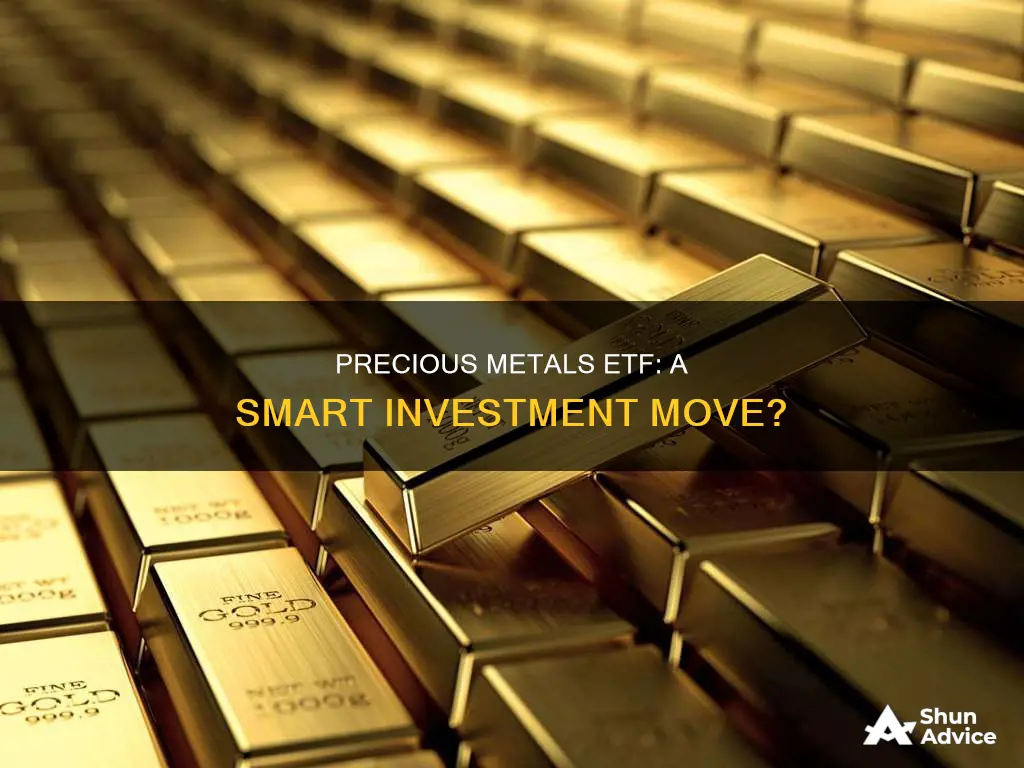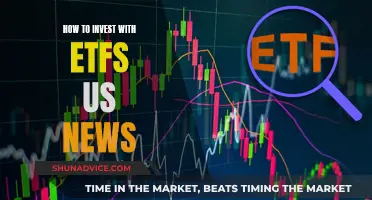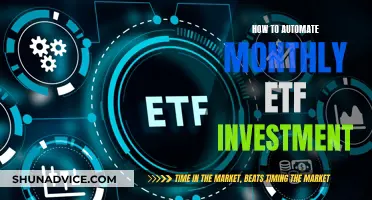
Investing in precious metals exchange-traded funds (ETFs) is an appealing option for investors seeking to diversify their portfolios. Precious metals ETFs invest in assets like gold, silver, and platinum, offering exposure to these markets without the challenges and expenses of physically owning and storing the metals. They are also relatively convenient and liquid, especially compared to transporting, securing, and holding the metals yourself. However, like other investments, precious metals ETFs come with certain risks, including volatility in metal prices and potential counterparty risks. When considering investing in precious metals ETFs, it is essential to evaluate factors such as expense ratios, liquidity, tracking errors, and the fund's investment strategy.
| Characteristics | Values |
|---|---|
| Purpose | Hedge against inflation and economic uncertainty |
| Investment type | Exchange-traded funds (ETFs) |
| Investment focus | Gold, silver, platinum, palladium, or a combination of these |
| Benefits | Closer price correlation, straightforward investing, diversification, liquidity |
| Risks | Volatile metal prices, inaccurately tracking performance, counterparty risk |
What You'll Learn

Gold ETFs
Gold Exchange-Traded Funds (ETFs) are investment funds that give investors the opportunity to invest in gold without the need to physically purchase, store, and resell the metal. Gold ETFs can track the price of gold or invest in companies within the gold mining industry. The issuing company either buys stock in gold-related companies or purchases and securely stores gold bullion.
Benefits of Gold ETFs:
- Diversification and Hedging: Gold is often viewed as a hedge against inflation and economic uncertainty. Adding gold ETFs to your portfolio can help reduce risk by diversifying across different asset classes.
- Convenience and Liquidity: Gold ETFs offer a convenient way to invest in gold without the hassles of transporting, securing, and holding physical gold. They are highly liquid, allowing investors to easily buy and sell shares at prevailing market prices.
- Lower Costs: Trading gold ETFs is generally commission-free, and they tend to have lower expense ratios compared to other investment options.
Types of Gold ETFs:
There are two main types of gold ETFs:
- Physical Gold ETFs: These ETFs directly hold gold bullion in secure vaults. They aim to replicate the performance of the gold market by providing a close correlation between the ETF's share price and the price of gold.
- Gold Mining ETFs: These ETFs invest in companies involved in the exploration, mining, refining, and trading of gold. The performance of these ETFs is tied to the value of the underlying companies and can offer exposure to the volatility of gold prices.
Factors to Consider:
When investing in gold ETFs, it's important to consider the following:
- Expense Ratios: Compare the expense ratios of different gold ETFs, as these fees can impact your net returns over time.
- Liquidity: Assess the average daily trading volume to understand how easily you can enter and exit your positions.
- Tracking Error: Evaluate the ETF's performance over time and its ability to accurately track the underlying asset's price changes.
- Investment Strategy: Understand the investment strategy of the ETF, such as whether it focuses on physical gold holdings or derivatives.
Examples of Gold ETFs:
- SPDR Gold MiniShares Trust: This ETF offers exposure to gold by tracking the price of gold bullion.
- Abrdn Physical Gold Shares ETF: This ETF provides direct investment in physical gold stored in secure vaults.
- IShares Gold Trust Micro: This ETF aims to replicate the performance of gold prices by holding physical gold.
- VanEck Merk Gold ETF: This ETF offers investors a way to invest in gold through a combination of physical gold holdings and derivatives.
How to Invest in Gold ETFs:
- Find a Gold ETF: Search for gold ETFs on your broker's website or through an online brokerage platform.
- Analyze the ETF: Research the ETF's performance, checking its historical returns and expense ratio.
- Buy the Gold ETF: Purchase shares in the gold ETF through your broker, just as you would buy a stock. Consider dollar-cost averaging by investing a fixed amount at regular intervals.
[CONTINUED IN NEXT RESPONSE]
Invest in ETF MJ: A Guide to Getting Started
You may want to see also

Silver ETFs
There are several Silver ETFs available, each with its own unique features and benefits. Here is a detailed overview of some of the top Silver ETFs:
IShares Silver Trust (SLV)
IShares Silver Trust is the largest silver ETF, holding physical silver bars stored in bank vaults. It offers investors a straightforward way to participate in silver price increases with lower risks and hassles compared to alternative investments like silver stocks or coins. The fund has high liquidity, trading around 16 million shares over 30 days, and a reasonable expense ratio of 0.5%.
Sprott Physical Silver Trust (PSLV)
Technically a closed-end fund, PSLV shares may trade at a premium or discount to its net asset value (NAV). It holds approximately $3.8 billion in assets, representing over 170 million ounces of silver, stored with the Royal Canadian Mint. PSLV has a slightly higher expense ratio of 0.59%.
Abrdn Physical Silver Shares ETF (SIVR)
SIVR provides exposure to physically-backed silver bullion held in London vaults, with regular inspections for transparency. The fund has over $900 million in assets and charges a 0.3% expense ratio.
Global X Silver Miners ETF (SIL)
SIL is a silver miner ETF that tracks an index of 32 globally diversified silver mining and streaming companies, with a focus on Canadian equities. It offers indirect exposure to silver prices, and mining companies can benefit from expanding production as profit margins grow. SIL has an expense ratio of 0.65%.
Amplify Junior Silver Miners ETF (SILJ)
SILJ provides exposure to smaller, riskier junior mining companies that primarily focus on silver exploration and development. These companies can be thought of as high-risk, high-reward investments. The ETF has a 0.69% expense ratio.
ProShares Ultra Silver (AGQ)
AGQ is a leveraged ETF that offers short-term enhanced exposure to silver prices, targeting a daily return two times that of the Bloomberg Silver Subindex. However, it is not suitable for long-term investors due to high volatility and compounding returns. AGQ has a high expense ratio of 0.95%.
ETFs: Commission-Free Investing for Long-Term Wealth
You may want to see also

Platinum ETFs
There are two main types of platinum ETFs: those structured as grantor trusts, which hold physical platinum bullion in vaults, and those structured as exchange-traded notes (ETNs), which invest in futures contracts that track the price of platinum.
- Abrdn Standard Physical Platinum Shares ETF (PPLT): This ETF is designed to track the spot price of platinum after deducting fund expenses. It is backed by physical platinum held in secure vaults in London and Zurich and is traded on the NYSE Arca electronic exchange. As of September 2, 2022, it had a one-year trailing total return of -16.8% and an expense ratio of 0.60%.
- GraniteShares Platinum Trust (PLTM): This ETF is also structured as a grantor trust and aims to track the spot price of platinum. It is backed by physical platinum held in a vault in London, which is inspected twice a year. The ETF is listed on NYSE Arca and had a one-year trailing total return of -16.0% and an expense ratio of 0.50% as of September 2, 2022.
- IPath Series B Bloomberg Platinum Subindex Total Return ETN (PGM): This is the only platinum ETF structured as an ETN. It invests in futures contracts that track the price of platinum, rather than holding physical platinum. It had a one-year trailing total return of -18.0% and an expense ratio of 0.45% as of September 2, 2022.
- IShares MSCI Global Metals & Mining Producers ETF (PICK): This ETF offers exposure to mining stocks, including platinum producers, rather than investing directly in platinum. It has an annual expense ratio of 0.39% and has returned about 50% over the past decade when dividends are reinvested.
It is important to note that platinum prices can be highly volatile and are closely tied to the global automobile industry and other cyclical industries. Therefore, investors should carefully consider their investment strategy and conduct thorough research before investing in platinum ETFs.
Weed ETF Investment: Getting Started and Growing Your Portfolio
You may want to see also

Palladium ETFs
The market for palladium is small, and prices are prone to volatility. This volatility is largely driven by supply and demand dynamics. For example, in 2020, Russia and South Africa accounted for 43% and 33% of the world's palladium supply, respectively. As a result, investors interested in adding palladium to their portfolios may find ETFs to be a convenient option.
- Abrdn Standard Physical Palladium Shares ETF: This ETF allows investors to invest directly in palladium. It is one of the few ways to invest directly in palladium, as few mining companies focus on producing it. The ETF holds the precious metal in bank vaults and has a reasonable expense ratio of 0.6%.
- Sprott Physical Platinum & Palladium Trust: This ETF holds physical bullion instead of derivative securities. As of March 4, 2022, the ETF held more than 58,000 ounces of platinum and 43,000 ounces of palladium. The fund has an annual expense ratio of 1.07%.
- Abrdn Standard Physical Precious Metals Basket Shares ETF: This ETF invests in a variety of precious metals, including gold, silver, platinum, and palladium. It provides investors with diversified exposure to multiple precious metals in a single vehicle. As of mid-2024, the fund's net assets were approximately 65% gold, 27% silver, 5% palladium, and 3% platinum. The ETF has a reasonable expense ratio of 0.6%.
A Guide to Investing in the HMMJ ETF
You may want to see also

Mining stocks ETFs
There are three types of precious metals ETFs:
- Those that hold the commodities directly
- Those that invest in derivatives based on the commodities' prices
- Those that invest in companies that extract, process, and exchange these metals
The benefits of investing in mining stocks ETFs include:
- Diversification: They can add diversification to an investment portfolio by providing exposure to precious metals markets without the need to physically own and store the metals.
- Hedge against inflation: Precious metals like gold are often seen as a hedge against inflation and economic uncertainty.
- Liquidity: They are relatively liquid and can be easily traded on major stock exchanges, providing flexibility in managing the investment.
- Lower costs: Trading precious metals ETFs is generally commission-free, and there are no additional costs associated with storing, transporting, and securing physical metals.
However, it's important to consider the risks and limitations of mining stocks ETFs. The prices of precious metals can be volatile, and the funds may not accurately track the performance of the underlying assets. Additionally, there is counterparty risk associated with the financial institutions backing the ETF.
When considering investing in mining stocks ETFs, it's essential to evaluate factors such as expense ratios, liquidity, tracking errors, and the fund's investment strategy.
Some popular mining stocks ETFs include:
- SPDR Gold Shares (GLD)
- IShares Gold Trust (IAU)
- IShares Silver Trust
- Abrdn Physical Platinum Shares ETF (PPLT)
- SPDR S&P Metals & Mining ETF (XME)
- IShares MSCI Global Metals & Mining Producers ETF (PICK)
XBI SPDR S&P Biotech ETF: Unity Biotechnology Investment Analysis
You may want to see also
Frequently asked questions
Precious metals ETFs are investment funds that hold assets like gold, silver, and platinum, offering exposure to these markets without the need to physically own and store the metals.
Precious metals ETFs can provide a hedge against inflation and economic uncertainty. They also offer diversification and liquidity to an investment portfolio, and are more convenient and cost-effective compared to physically purchasing and storing precious metals.
Precious metals ETFs carry the risk of price volatility as they fluctuate with metal prices. There is also counterparty risk, where issues with the fund's management or backing institutions can impact the investment value and returns.
When choosing a precious metals ETF, consider factors such as expense ratios, liquidity, tracking errors, and the fund's investment strategy. Compare different ETFs to find one that aligns with your investment goals and risk tolerance.
Some popular precious metals ETFs include SPDR Gold Shares (GLD), iShares Silver Trust (SLV), and abrdn Physical Platinum Shares ETF (PPLT). These ETFs offer exposure to gold, silver, and platinum, respectively, and have relatively high assets under management (AUM).







